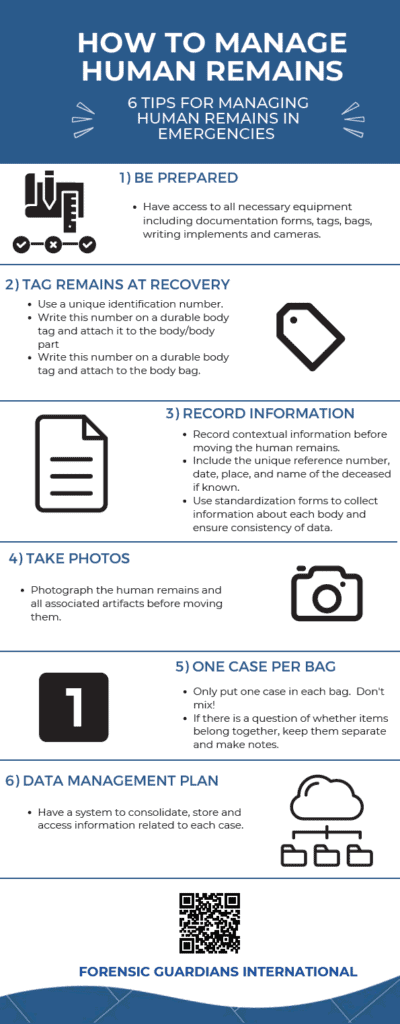What is Forensic Identification?
Forensic identification is a determination of identity based on specific and scientific matching of information between a missing person and unidentified human remains. The matching should be based on multiple factors and consider all the scientific information that is available. Factors could include details such as DNA profiles, dental records, biological information, and other distinguishing factors. Identifications using only one scientific feature should be avoided as much as possible.
Why is Forensic Identification Important?
The identification of human remains is important for both legal and humanitarian reasons. Without legal confirmation and certification of death, it is often difficult for living family members to proceed with administrative issues. From a humanitarian point of view, families often need to understand what has happened to their loved one and be able to carry out their death rituals and commemorations.

How are Human Remains Identified?
There are 3 main parts of forensic identification:
Research
- This stage involves understanding as much information as possible about who is missing and/or unaccounted for, information about potential grave sites and the factors that led to the creation of the site, and as much information as possible about who could be in potential grave(s).
- This stage often carries on throughout the duration of an identification project. It does not start and stop but is a constant process to collect more information.
- This stage often carries on throughout the duration of an identification project. It does not start and stop but is a constant process to collect more information.
Collection of information from families
This stage is typically referred to as the collection of ante-mortem information. This includes collecting as much information as possible about each individual that is missing and includes details such as age, height, weight as well as other physical information that helps to distinguish an individual.
Generally, this information is provided by close family members who knew the missing person well and could speak to their physical appearance, medical and dental history. Information about physical items that the missing person may have carried with them or have been wearing is also collected in this stage.
DNA reference samples are typically collected from family members of the missing person(s) during this stage to assist with the identification of unidentified human remains. This process is complementary to ante-mortem data collection and both types of data should be used in combination during identification efforts.
A DNA sample is a specimen taken from family members and is generally in the form of either a buccal swab (saliva) or a blood sample. It can be analysed in a genetic laboratory to generate a genetic code, known as a DNA profile. DNA is the material in cells, which stores the inherited traits that make up our bodies. Each person has his/her own unique genetic code, known as a DNA profile. This code remains constant through life and after death. DNA of close biological relatives is structured similarly. DNA
contains unique genetic characteristics for identifying a person even when no other features are present.
On its own, a DNA profile extracted from human remains does not permit identification of a person. It is through comparison of DNA profiles taken from families and samples taken from the unidentified human remains, that it is possible to show potential statistical relationship.
The ability to match a missing person(s) to their relatives depends on how closely related the person/people that provide the sample are to the missing person. The most useful samples are from close blood relatives such as the missing person’s biological mother, father, children, brothers and sisters.

Recovery and analysis of the human remains
The use of appropriate and proper recovery techniques and the management of the human remains and associated evidence is essential in the forensic identification process. Typically, archaeological techniques
are applied with modifications to a forensic setting. Maintaining the provenience of human remains to one another and to any artifact that is associated to them is essential. Chain of custody and data management plays a very important role in this aspect of the work to ensure the integrity of information. The use of proper recovery techniques supports the recovery of all human remains and information associated to each skeleton including small items such as personal effects. Using proper recovery techniques reduces the chance of unintentional mixing human remains and allows for documentation of all findings including determinations of whether the grave is a primary or secondary grave.
Data management is a critical element of the forensic identification process. Collection and storage of antemortem data, potential gravesite information, data about each gravesite, the recovery of remains as well and the data from each skeleton must be stored in a secure database. Ideally this database facilitates matching of antemortem, and post-mortem information by professionals.
How are Human Remains Identified?
The scientific identification of any missing person involves the comparison of antemortem data collected from families about their missing loved ones with data collected by forensic experts during their examinations, which is called postmortem data. If there is a match between the antemortem and postmortem data, and this is supported by circumstantial evidence, then it is possible to know that the human remains analyzed by the forensic expert are those of the suspected missing person about whom the family has provided the information. There must be a match in all lines of investigation to have a positive identification.

